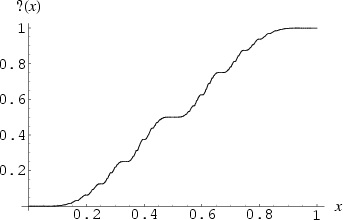
The function ![]() defined by Minkowski for the purpose of mapping the rational numbers in the open interval
defined by Minkowski for the purpose of mapping the rational numbers in the open interval ![]() into the quadratic irrational numbers of
into the quadratic irrational numbers of ![]() in a continuous, order-preserving manner.
in a continuous, order-preserving manner. ![]() takes a number having continued fraction
takes a number having continued fraction ![]() to the number
to the number
 |
(1) |
The function satisfies the following properties (Salem 1943).
- 1.
 is strictly increasing.
is strictly increasing. - 2. If x is rational, then
 is of the form
is of the form  ,
, - 3. If x is a quadratic irrational number, then the continued fraction is periodic, and hence
 is rational.
is rational. - 4. The function is purely singular (Denjoy 1938).
![]() can also be constructed as
can also be constructed as
| (2) |
where ![]() and
and ![]() are two consecutive irreducible fractions from the Farey sequence. At the nth stage of this definition,
are two consecutive irreducible fractions from the Farey sequence. At the nth stage of this definition, ![]() is defined for
is defined for ![]() values of x, and the ordinates corresponding to these values are
values of x, and the ordinates corresponding to these values are ![]() for k = 0, 1, ...,
for k = 0, 1, ..., ![]() (Salem 1943).
(Salem 1943).
The function satisfies the identity
| (3) |
A few special values include
where
![]()
Devil's Staircase, Farey Sequence
![]()
![]()
Conway, J. H. "Contorted Fractions." On Numbers and Games, 2nd ed. Natick, MA: A. K. Peters, pp. 82-86 (1st ed.), 2000.
Denjoy, A. "Sur une fonction réelle de Minkowski." J. Math. Pures Appl. 17, 105-155, 1938.
Girgensohn, R. "Constructing Singular Functions via Farey Fractions." J. Math. Anal. Appl. 203, 127-141, 1996.
Kinney, J. R. "Note on a Singular Function of Minkowski." Proc. Amer. Math. Soc. 11, 788-794, 1960.
Minkowski, H. "Zur Geometrie der Zahlen." In Gesammelte Abhandlungen, Vol. 2. New York: Chelsea, pp. 44-52, 1991.
Salem, R. "On Some Singular Monotone Functions which Are Strictly Increasing." Trans. Amer. Math. Soc. 53, 427-439, 1943.
Tichy, R. and Uitz, J. "An Extension of Minkowski's Singular Functions." Appl. Math. Lett. 8, 39-46, 1995.
Viader, P.; Paradis, J.; and Bibiloni, L. "A New Light on Minkowski's ![]() Function." J. Number Th. 73, 212-227, 1998.
Function." J. Number Th. 73, 212-227, 1998.